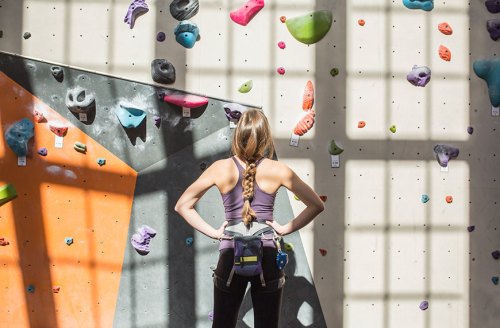If you ever want to be awestruck by another human’s strength and ability, just watch a rock climber gracefully scaling a 1,000-foot wall like it’s no big deal. In order to make those impressive climbs, their bodies not only need to be strong, but properly stretched out. Whether you’re destined to become a pro climber or not, you can learn their special technique for upper-body stretches without climbing to the highest heights.
Emilie Childress, the rock climber and web developer behind The Coding Climber, has been climbing since the age of 8. While climbing regularly certainly improves strength, she wouldn’t have been able to complete so many tough climbs without focusing on recovery and mobility, too.
“It’s important to stretch as a rock climber to prevent injury and ease muscle tightness. It can also speed up workout recovery time and increase your overall range of motion,” says Childress. “Stretching improves climbing ability because it increases flexibility, making it easier to do climbing moves such as stemming, heel hooks, and high-steps. But a consistent stretching practice is important whether you want to have a long-term relationship with climbing or any physical activity.”
To prepare your body for whatever type of exercise you’re into, try these climber-approved stretches.
Upper-body stretches rock climbers do to stay limber
1. Bicep stretch
The biceps are one of the primary upper arm muscles used in climbing. “They’re used for holding onto underclings,” says Childress.
How to stretch your biceps:
- Sit on the floor with your knees bent and feet flat on the floor.
- Place your hands with palms flat on the floor behind you. Make sure your fingers are pointing away from your body.
- Keeping your palms on the floor in one place, slide your butt away from your hands until you feel a nice stretch in your biceps.
2. Forearm stretch
Pain-free is the way to be, and stretching the forearms is crucial in making sure your body stays happy. “It’s important to stretch the forearms to avoid elbow pain and tendonitis, which are both common injuries in climbing,” she says.
How to stretch your forearms:
- My go-to stretch is a table top pose variation. Start on your palms and knees in table pose.
- Keep your hands shoulder width apart and rotate your wrists so your fingers point to your knees.
- Sit back on your heels and hold for 30 seconds.
3. Back stretch
Upper-body stretches for your back are important to help you move properly during your everyday workouts. “It increases your range of motion,” she says.
How to stretch your back:
- My go-to stretch is Child’s Pose. Start with your hands and knees on the mat.
- Spread your knees with your feet together (big toes touching) and the tops of your feet flat on the floor.
- Rest your stomach between your thighs and bring your forehead to the floor.
- Extend your arms in front of you with your palms towards the floor and stretch for one minute.
4. Hands and fingers stretch
Stretching your hands often doesn’t just help at the gym. It also helps in your everyday life. “It’s important to stretch your hands to prevent finger injuries and increase blood flow,” says Childress.
How to stretch your hands:
- My go-to stretch uses rubber bands. First, close your hand with all your finger tips touching.
- Wrap the three rubber bands around your fingers.
- Open your hand with the rubber bands around it, and then close again.
- Repeat 10 times and then repeat on the other hand. Complete three sets total.
5. Wrist stretch
Just like your hands, your wrists can benefit from regular stretching. “Stretching your wrists helps prevent tightness and increases mobility,” she says. “My go-to wrist stretch is handstands. They also help improve upper body strength and improve mental clarity.”
How to stretch your wrists:
- If you need to improve balance and strength, start out doing wall handstands.
- Situate yourself near a wall. With your back to the wall, put your hands on the floor.
- Bring one foot up behind you on the wall, then the other, and slowly walk your legs up the wall.
- Walk your hands closer to the wall so your body is straight.
- You can also start facing the wall by placing your hands on the floor and slowly kicking your legs up to the wall.
Don’t stop there. Next, try these hamstring stretches:
Here’s why lifting weights has been found to crush depressive symptoms while it boosts your biceps. Then learn about the one-second pause—aka the best way to get the most out of every strength training move.
Sign Up for Our Daily Newsletter
Get all the latest in wellness, trends, food, fitness, beauty, and more delivered right to your inbox.
Got it, you've been added to our email list.











